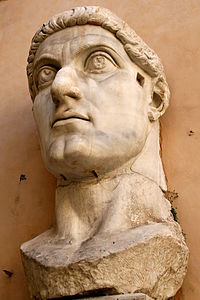Constantine the Great Religious rules | References | Other websites | Navigation menu"Constantine the Great, the Reorganisation of the Empire and the Triumph of the Church"Book 1Book 2Book 3Encyclopaedia Britannica, Constantine I12 Byzantine RulersConstantine IConstantine the GreatHouse of Constantine bronze coinsBBC North Yorkshire's site on Roman York, Yorkshire and Constantine the Greatlist of Roman laws of the fourth centuryProfessor Edwin Judge discusses Constantine's legacy for a Centre for Public Christianity vodcastConstantine's time in York on the 'History of York'e

Multi tool use
272 births337 deathsByzantine Emperors
Roman EmpireIstanbulTurkeyGreekMilvian BridgeTiber RivercrossLatindeityApolloJesuspaganlawChristianityCatholic ChurchFirst Council of NiceabaptizedEastern OrthodoxChurchEdict of Milanmartyred,freedom of religionGaleriusArch of ConstantineApolloDianaHerculeseastern sun-worshipAurelianDiademRoman CatholicEastern CatholicIndependent CatholicOld CatholicLutheranReformedAnabaptistBaptistAnglicanMethodistEvangelicalHolinessPentecostalEastern OrthodoxOriental OrthodoxAssyrian
Constantine the Great
Jump to navigation
Jump to search

Constantine I
Constantine I (27 February 272 – 22 May 337 AD) was a powerful general who reigned over the Roman Empire as emperor until his death. He made the previously named city Byzantium (now Istanbul, Turkey) capital of the whole Roman Empire. As emperor, he named the city Constantinople, which means "City of Constantine" in Greek.
Before Constantine became Emperor, he was fighting for the throne at the Battle of Milvian Bridge over the Tiber River. When he saw a cross in the sky with the words in hoc signo vinces (Latin for "in this sign you shall conquer"), he changed his deity from Apollo to Jesus and won the battle.
In pagan Rome before this, it had been against the law to believe in Christianity, and Christians had often been tortured or killed. Constantine protected them. He went on to organize the whole Catholic Church at the First Council of Nicea, even though he himself did not get baptized until near the end of his life.
Constantine was also a big part of the beginning of the Eastern Orthodox religion, after changing the point from which he ruled from Rome to Byzantium.
Religious rules |

Constantine the Great, mosaic in Hagia Sophia, c. 1000
Constantine is perhaps best known for being the first Christian Roman emperor. His rule changed the Church greatly. In February 313, Constantine met with Licinius in Milan where they made the Edict of Milan. The edict said that Christians could believe what they wanted.[1] This stopped people from punishing Christians, who had often been martyred, or killed for their faith. It also returned the property which had been taken away from them. The edict not only protected Christians, but gave freedom of religion to all, allowing anyone to worship whatever they wanted. In 311, Galerius had made a similar edict, though it did not return any property to them.[2]
Constantine did not support Christianity alone. After winning the Battle of the Milvian Bridge, he built the Arch of Constantine) to celebrate, but the arch was decorated with pictures of sacrifices to gods like Apollo, Diana, or Hercules. It had no Christian symbolism. In 321, Constantine said that Christians and non-Christians should all join the "day of the sun" (the eastern sun-worship which Aurelian had helped him introduce). His coins also had symbols of the sun-cult until 324. Even after pagan gods disappeared from the coins, Christians symbols never appeared on the coin, either.[3] Even when Constantine dedicated the new capital of Constantinople, he was wearing the Apollonian sun-rayed Diadem.
References |
↑ Bowder, Diana. The Age of Constantine and Julian. New York: Barnes & Noble, 1978
↑ See Lactantius, De Mortibus Persecutorum 34–35.
↑ Cf. Paul Veyne, Quand notre monde est devenu chrétien, 163.
Other websites |
 Media related to Constantine the Great at Wikimedia Commons
Media related to Constantine the Great at Wikimedia Commons
Firth, John B. "Constantine the Great, the Reorganisation of the Empire and the Triumph of the Church" (BTM)..mw-parser-output cite.citationfont-style:inherit.mw-parser-output .citation qquotes:"""""""'""'".mw-parser-output .citation .cs1-lock-free abackground:url("//upload.wikimedia.org/wikipedia/commons/thumb/6/65/Lock-green.svg/9px-Lock-green.svg.png")no-repeat;background-position:right .1em center.mw-parser-output .citation .cs1-lock-limited a,.mw-parser-output .citation .cs1-lock-registration abackground:url("//upload.wikimedia.org/wikipedia/commons/thumb/d/d6/Lock-gray-alt-2.svg/9px-Lock-gray-alt-2.svg.png")no-repeat;background-position:right .1em center.mw-parser-output .citation .cs1-lock-subscription abackground:url("//upload.wikimedia.org/wikipedia/commons/thumb/a/aa/Lock-red-alt-2.svg/9px-Lock-red-alt-2.svg.png")no-repeat;background-position:right .1em center.mw-parser-output .cs1-subscription,.mw-parser-output .cs1-registrationcolor:#555.mw-parser-output .cs1-subscription span,.mw-parser-output .cs1-registration spanborder-bottom:1px dotted;cursor:help.mw-parser-output .cs1-ws-icon abackground:url("//upload.wikimedia.org/wikipedia/commons/thumb/4/4c/Wikisource-logo.svg/12px-Wikisource-logo.svg.png")no-repeat;background-position:right .1em center.mw-parser-output code.cs1-codecolor:inherit;background:inherit;border:inherit;padding:inherit.mw-parser-output .cs1-hidden-errordisplay:none;font-size:100%.mw-parser-output .cs1-visible-errorfont-size:100%.mw-parser-output .cs1-maintdisplay:none;color:#33aa33;margin-left:0.3em.mw-parser-output .cs1-subscription,.mw-parser-output .cs1-registration,.mw-parser-output .cs1-formatfont-size:95%.mw-parser-output .cs1-kern-left,.mw-parser-output .cs1-kern-wl-leftpadding-left:0.2em.mw-parser-output .cs1-kern-right,.mw-parser-output .cs1-kern-wl-rightpadding-right:0.2em- Letters of Constantine: Book 1, Book 2, & Book 3
- Encyclopaedia Britannica, Constantine I
12 Byzantine Rulers by Lars Brownworth of Stony Brook School (grades 7–12). 40 minute audio lecture on Constantine.
Constantine I in the 1911 Encyclopædia Britannica
Constantine the Great A site about Constantine the Great and his bronze coins emphasizing history using coins, with many resources including reverse types issued and reverse translations.
House of Constantine bronze coins Illustrations and descriptions of coins of Constantine the Great and his relatives.- BBC North Yorkshire's site on Roman York, Yorkshire and Constantine the Great
- This list of Roman laws of the fourth century shows laws passed by Constantine I relating to Christianity.
- Professor Edwin Judge discusses Constantine's legacy for a Centre for Public Christianity vodcast
- Constantine's time in York on the 'History of York'
Categories:
- 272 births
- 337 deaths
- Byzantine Emperors
(RLQ=window.RLQ||[]).push(function()mw.config.set("wgPageParseReport":"limitreport":"cputime":"0.176","walltime":"0.248","ppvisitednodes":"value":365,"limit":1000000,"ppgeneratednodes":"value":0,"limit":1500000,"postexpandincludesize":"value":23994,"limit":2097152,"templateargumentsize":"value":241,"limit":2097152,"expansiondepth":"value":12,"limit":40,"expensivefunctioncount":"value":0,"limit":500,"unstrip-depth":"value":0,"limit":20,"unstrip-size":"value":2792,"limit":5000000,"entityaccesscount":"value":1,"limit":400,"timingprofile":["100.00% 186.411 1 -total"," 52.46% 97.785 1 Template:Cite_web"," 18.93% 35.294 1 Template:Christianityfooter"," 16.49% 30.739 1 Template:Navbox"," 15.53% 28.945 1 Template:Commonscat-inline"," 12.86% 23.979 1 Template:Reflist"," 12.60% 23.483 1 Template:Sister-inline"," 2.05% 3.824 1 Template:Main_other"," 1.87% 3.480 52 Template:·"],"scribunto":"limitreport-timeusage":"value":"0.075","limit":"10.000","limitreport-memusage":"value":1626348,"limit":52428800,"cachereport":"origin":"mw1309","timestamp":"20191128190837","ttl":2592000,"transientcontent":false););"@context":"https://schema.org","@type":"Article","name":"Constantine the Great","url":"https://simple.wikipedia.org/wiki/Constantine_the_Great","sameAs":"http://www.wikidata.org/entity/Q8413","mainEntity":"http://www.wikidata.org/entity/Q8413","author":"@type":"Organization","name":"Contributors to Wikimedia projects","publisher":"@type":"Organization","name":"Wikimedia Foundation, Inc.","logo":"@type":"ImageObject","url":"https://www.wikimedia.org/static/images/wmf-hor-googpub.png","datePublished":"2006-06-17T17:12:08Z","dateModified":"2019-11-18T16:31:30Z","image":"https://upload.wikimedia.org/wikipedia/commons/2/20/0_Constantinus_I_-_Palazzo_dei_Conservatori_%282%29.JPG","headline":"Roman emperor"(RLQ=window.RLQ||[]).push(function()mw.config.set("wgBackendResponseTime":134,"wgHostname":"mw1273"););zgmKhQMUVqyWybfS,IesJEk3Zk,cszlMPyzDQWnVprQs WRtoB
